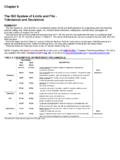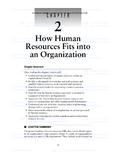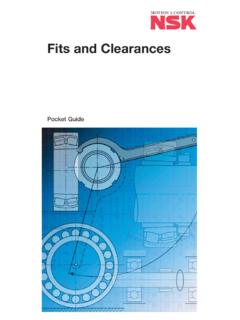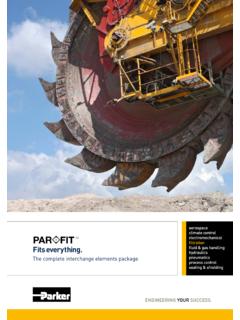Transcription of 9. FITS AND INTERNAL CLEARANCES
1 A 82A Importance of Proper FitsIn the case of a rolling bearing with the inner ring fitted to the shaft with only slight interference, a harmful circumferential slipping may occur between the inner ring and shaft. This slipping of the inner ring, which is called creep , results in a circumferential displacement of the ring relative to the shaft if the interference fit is not sufficiently tight. When creep occurs, the fitted surfaces become abraded, causing wear and considerable damage to the shaft. Abnormal heating and vibration may also occur due to abrasive metallic particles entering the interior of the is important to prevent creep by having sufficient interference to firmly secure that ring which rotates to either the shaft or housing. Creep cannot always be eliminated using only axial tightening through the bearing ring faces.
2 Generally, it is not necessary, however, to provide interference for rings subjected only to stationary loads. fits are sometimes made without any interference for either the inner or outer ring, to accommodate certain operating conditions, or to facilitate mounting and dismounting. In this case, to prevent damage to the fitting surfaces due to creep, lubrication of other applicable methods should be Selection of Fit(1) Load Conditions and FitThe proper fit may be selected from Table based on the load and operating conditions.(2) Magnitude of Load and InterferenceThe interference of the inner ring is slightly reduced by the bearing load; therefore, the loss of interference should be estimated using the following equations:where &dF : Interference decrease of inner ring (mm) d : Bearing bore diameter (mm) B : Nominal inner ring width (mm) Fr : Radial load applied on bearing (N), {kgf}9.
3 fits AND INTERNAL CLEARANCEST herefore, the effective interference &d should be larger than the interference given by Equation ( ).However, in the case of heavy loads where the radial load exceeds 20% of the basic static load rating C0r, under the operating condition, interference often becomes shortage. Therefore, interference should be estimated using Equation ( ):where &d : Effective interference (mm) Fr : Radial load applied on bearing (N), {kgf} B : Nominal inner ring width (mm)(3) Interference Variation Caused by Temperature Difference between Bearing and Shaft or HousingThe effective interference decreases due to the increasing bearing temperature during operation. If the temperature difference between the bearing and housing is &T ( C), then the temperature difference between the fitted surfaces of the shaft and inner ring is estimated to be about ( ~ ) &T in case that the shaft is cooled.
4 The decrease in the interference of the inner ring due to this temperature difference &dT may be calculated using Equation ( ):&dT = ( to ) &T d d 10 3 ..( )where &dT : Decrease in interference of inner ring due to temperature difference (mm) &T : Temperature difference between bearing interior and surrounding parts ( C) : Coefficient of linear expansion of bearing steel= 10 6 (1/ C) d : Bearing nominal bore diameter (mm)In addition, depending on the temperature difference between the outer ring and housing, or difference in their coefficients of linear expansion, the interference may increase.(4) Effective Interference and Finish of Shaft and HousingSince the roughness of fitted surfaces is reduced during fitting, the effective interference becomes less than the apparent interference.
5 The amount of this interference decrease varies depending on the roughness of the surfaces and may be estimated using the following equations:For ground shaftsFor machined shaftswhere &d : Effective interference (mm) &da : Apparent interference (mm) d : Bearing nominal bore diameter (mm)According to Equations ( ) and ( ), the effective interference of bearings with a bore diameter of 30 to 150 mm is about 95% of the apparent interference.(5) Fitting Stress and Ring Expansion and ContractionWhen bearings are mounted with interference on a shaft or in a housing, the rings either expand or contract and stress is produced. Excessive interference may damage the bearings; therefore, as a general guide, the maximum interference should be kept under approximately 7/10 000 of the shaft pressure between fitted surfaces, expansion or contraction of the rings, and circumferential stress may be calculated using the equations in Section , Fitting(1) (Pages A130 and A131).
6 Recommended FitsAs described previously, many factors, such as the characteristics and magnitude of bearing load, temperature differences, means of bearing mounting and dismounting, must be considered when selecting the proper the housing is thin or the bearing is mounted on a hollow shaft, a tighter than usual fit is necessary. A split housing often deforms the bearing into an oval shape; therefore, a split housing should be avoided when a tight fit with the outer ring is required. The fits of both the inner and outer rings should be tight in applications where the shaft is subjected to considerable recommended fits for some common applications are shown in Table to In the case of unusual operating conditions, it is advisable to consult NSK. For the accuracy and surface finish of shafts and housings, please refer to Section (Page A100).
7 RotatingLoad ApplicationInner RingBearing OperationOuter RingLoadConditionsInner RingFittingOuter RingStationaryStationaryStationaryRotati ngRotating or StationaryDirection of load indeterminate due to variation of direction or unbalanced loadRotatingRotatingStationaryRotating or StationaryDirection of Load IndeterminateTight FitTight FitRotating Inner Ring Load Stationary Outer Ring LoadRotating Outer Ring LoadStationary Inner Ring LoadTight FitLoose FitLoose FitTight FitTable Loading Conditions and FitsLoadStationaryLoadRotatingLoadStatio naryLoadRotating&dF= 3(N)..dB&dF= 3dB{kgf}..( ) &d 3(N)..FrB&d {kgf}..( ) &d=&dadd+ ( )&d=&dadd+ ( ) 82-83 82-8311/20/13 4:51:45 PM11/20/13 4:51:45 PMA 84A 85 fits AND INTERNAL CLEARANCESLoad ConditionsRotating Outer Ring LoadRotating Inner Ring Load or Direction of Load IndeterminateAxial Loads OnlyAll Types of LoadingCentral Axial Load OnlyStationary Inner Ring LoadRotating Inner Ring Load or Direction of Load IndeterminateCombined Radial and Axial Loads (Spherical Thrust Roller Bearings)Easy axial displacement of inner ring on shaft Loads or Variable Loads(< (1))Normal Loads( to (1))Heavy Loads or Shock Loads(> (1))Easy axial displacement of inner ring on shaft unnecessaryWheels on Stationary AxlesElectrical HomeAppliances Pumps,Blowers, TransportVehicles, PrecisionMachinery,Machine ToolsGeneral BearingApplications,Medium andLarge Motors(3)
8 ,Turbines, Pumps,Engine MainBearings,Gears,WoodworkingMachinesRa ilway Axleboxes, Industrial Vehicles, Traction Motors, Construction Equipment, CrushersGeneral bearing Applications, Railway AxleboxesTransmission Shafts, Woodworking SpindlesMain Shafts of LathesCone CrushersPaper Pulp Refiners, Plastic Extruders<1818 to 100100 to 200 <1818 to 100100 to 140140 to 200200 to 280 <4040 to 140140 to 200 <4040 to 100100 to 140140 to 200200 to 400 50 to 140140 to 200over 200 <4040 to 6565 to 100100 to 140140 to 280280 to 500over 50050 to 100100 to 140140 to 200200 to 500js5js6(j6)k6m6js5 or js6 (j5 or j6)k5 or k6m5 or m6m6n6p6r6r7n6p6r6r7 All Shaft DiametersAll Shaft DiametersAll Shaft DiametersAll Shaft DiametersAll Shaft Diameters<200200 to 400over 400g6 Use g5 and h5 where accuracy is required. In case of large bearings, f6 can be used to allow easy axial and m6 can be used for single-row tapered rollerbearings and single-row angular contactball bearingsinstead of k5 than CN bearing INTERNAL clearance is necessary.
9 IT5 and IT7 mean that the deviation of the shaft from its true geometric form, e. g. roundness and cylindricity should be within the tolerances of IT5 and IT7 respectively. h6js6 (j6)h9/IT5(2)h10/IT7(2)h6 orjs6 (j6)js6 (j6)k6m6n6 Tension Pulleys Rope SheavesRadial Bearings with Cylindrical BoresRadial Bearings with Tapered Bores and SleevesExamplesBall BrgsCylindrical Roller Brgs, Tapered Roller BrgsSpherical Roller BrgsTolerance of ShaftRemarksShaft Diameter (mm)Table fits of Radial Bearings with ShaftsLoad ConditionsExamplesTolerance of ShaftRemarksShaft Diameter (mm)Table fits of Thrust Bearings with ShaftsNotes (1) Cr represents the basic load rating of the bearing. (2) Refer to Appendix Table 11 on page C22 for the values of standard tolerance grades IT. (3) Refer to Tables and for the recommended fits of shafts used in electric motors for deep groove ball bearings with bore diameters ranging from 10 mm to 160 mm, and for cylindrical roller bearings with bore diameters ranging from 24 mm to 200 This table is applicable only to solid steel ConditionsExamplesAxial Displacement of Outer RingRemarksTolerances for Housing BoresTable fits of Radial Bearings with HousingsNote (1) Refer to Tables and for the recommended fits of housing bores of deep groove ball bearings and cylindrical roller bearings for electric 1.
10 This table is applicable to cast iron and steel housings. For housings made of light alloys, the interference should be tighter than those in this table. 2. Refer to the introductory section of the bearing dimension tables (blue pages) for special fits such as drawn cup needle roller HousingsRotating Outer Ring LoadHeavy Loads on Bearing in Thin-Walled Housing or Heavy Shock LoadsAutomotive Wheel Hubs (Roller Bearings) Crane Travelling WheelsP7N7M7K7JS7 (J7)H7H8G7JS6 (J6)K6M6 or N6H6 Impossible Load ConditionsBearing TypesRemarksTolerances for Housing BoresTable fits of Thrust Bearings with HousingsAxial Loads OnlyStationary Outer Ring LoadsRotating Outer Ring Loads or Direction of Load IndeterminateCombined Radial and Axial LoadsThrust Ball BearingsSpherical Thrust Roller Bearings Steep Angle Tapered Roller BearingsSpherical Thrust Roller BearingsClearance over ring has radial or JS7 (J7)K7M7 For General ApplicationsWhen precision is requiredWhen radial loads are sustained by other LoadsRelatively Heavy Radial Loads If axial displacement of the outer ring is not displacement of outer ring is necessary.














